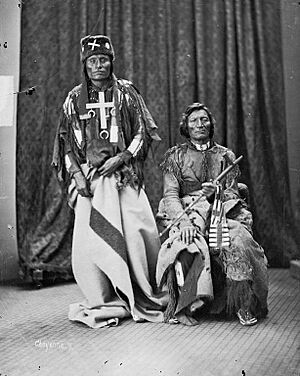Morning Star (chief) facts for kids
Quick facts for kids
Morning Star
|
|
|---|---|
| Vóóhéhéve | |
| Northern Cheyenne leader | |
| Personal details | |
| Born | ca. 1810 |
| Died | 1883 |
| Resting place | Lame Deer, Montana |
| Nicknames | Dull Knife (Tamílapéšni, Tah-me-la-phe-shnee or Motšêške Ôhnêxahpo) |
Morning Star (in Cheyenne: Vóóhéhéve; also known as Dull Knife) was a very important leader of the Northern Cheyenne people. He was born around 1810 and lived until 1883. He was the head chief of the Notameohmésêhese band, also called the "Northern Eaters," who lived on the northern Great Plains.
Morning Star is remembered for bravely standing up against the United States government and the expansion of settlers into Native American lands. Because of his courage and the strength of other leaders, the Northern Cheyenne people still have a homeland today in Montana.
Even though his Cheyenne name means "Morning Star," many settlers and U.S. military leaders knew him as "Dull Knife." People at the time described him as a remarkable leader who fought for his people's freedom.
A Life of Leadership

In 1851, Morning Star represented his tribe at the first Treaty of Fort Laramie. This treaty was an agreement between the U.S. government and several Native American tribes.
After a big battle known as Custer's Last Stand in 1876, Morning Star and his people joined forces with the Sioux and other tribes. They fought against the United States Army. However, after a strong attack by American soldiers, many Cheyenne were forced to give up. Their homes were destroyed, and their livestock were taken.
The Cheyenne people hoped to live on reservations with the Sioux in the north. But instead, they were moved far south to the Southern Cheyenne Reservation in what was called the Indian Territory.
The Journey Home
Life on the southern reservation was very hard. The Cheyenne could not hunt enough food, and many suffered from hunger and sickness. In September 1878, Morning Star made a brave decision. He led his tribe north, trying to return to their traditional homelands.
This journey was very difficult. The Cheyenne had to fight their way through federal troops across the plains. They managed to outsmart the soldiers for a while, even in the Nebraska Sand Hills. But eventually, they were captured near Fort Robinson.
The tribe had cleverly taken apart their guns and hidden the pieces. Some parts were hidden under blankets, and others were worn as necklaces or bracelets by children. Morning Star explained that his people would not fight anymore if they could live with Red Cloud on the Pine Ridge Indian Reservation. But the Army insisted they go back south.
On January 8, 1879, the Northern Cheyenne tried to escape from the fort using their hidden gun parts. However, they were quickly chased by soldiers. Many Cheyenne, especially women and children, were killed in what is known as the Fort Robinson massacre.
A few people managed to escape, including Morning Star. He eventually reached the Pine Ridge Agency. He was held there as a prisoner until he and the survivors were finally allowed to settle on a reservation near Fort Keogh in the Montana Territory. This was closer to their original homelands.
Lasting Legacy
Morning Star passed away in 1883. He is buried on the Northern Cheyenne reservation at Lame Deer Cemetery. To honor him, Chief Dull Knife College in Lame Deer is named after him. His photograph also appears in a famous book called Bury My Heart at Wounded Knee.
See also
 In Spanish: Cuchillo Desafilado para niños
In Spanish: Cuchillo Desafilado para niños

